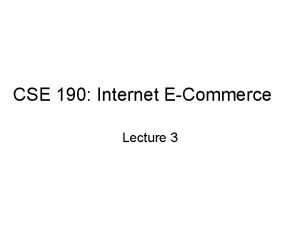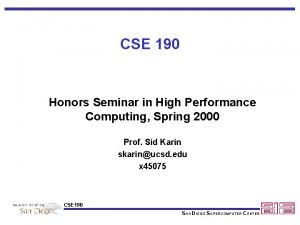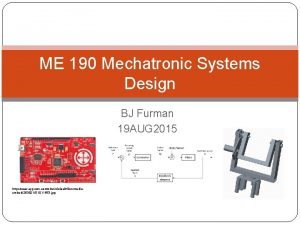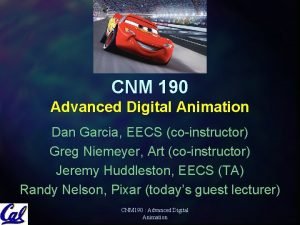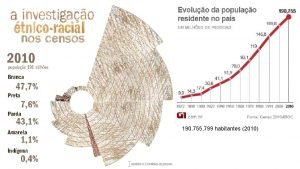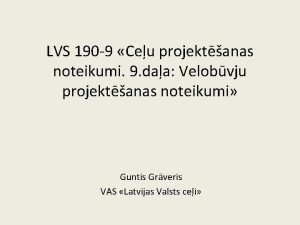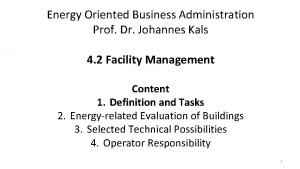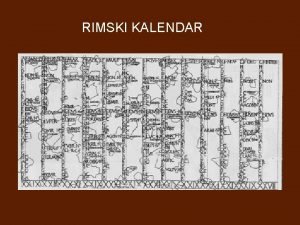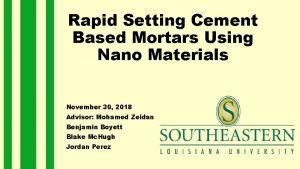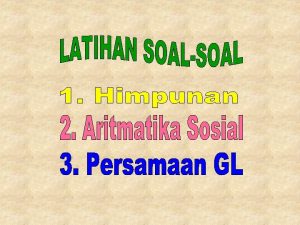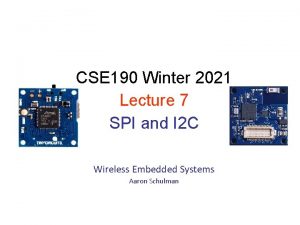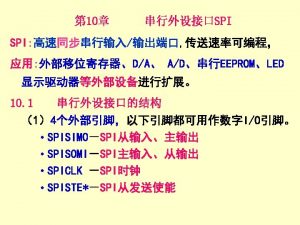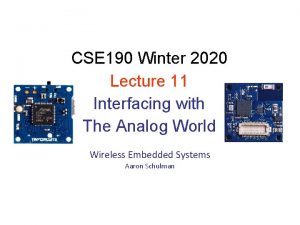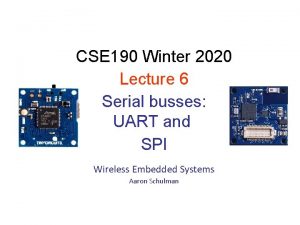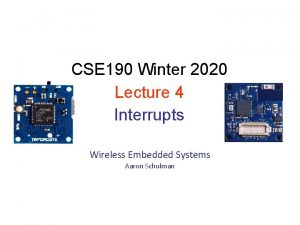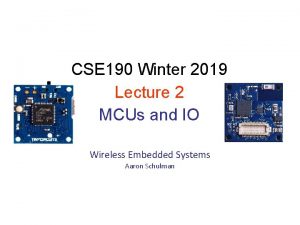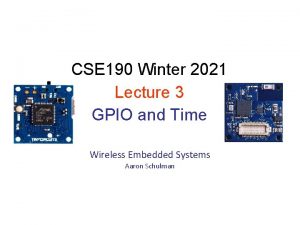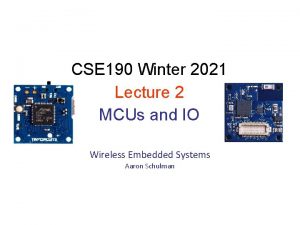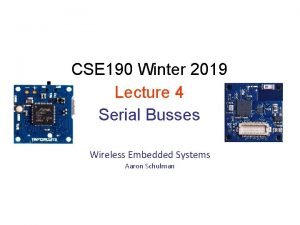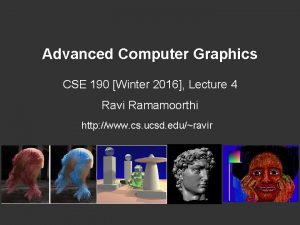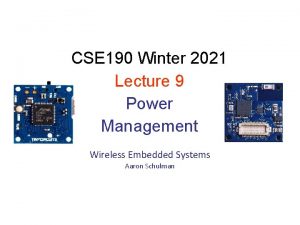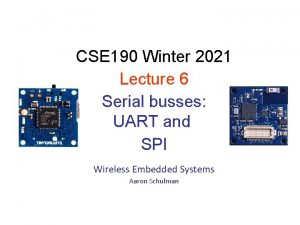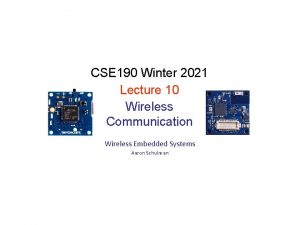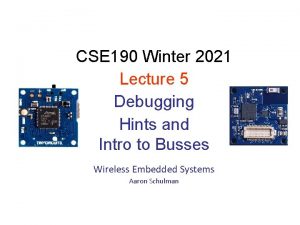CSE 190 Winter 2020 Lecture 7 SPI and

















- Slides: 17

CSE 190 Winter 2020 Lecture 7 SPI and I 2 C Wireless Embedded Systems Aaron Schulman

SPI Communication 2

SPI clocking: there is no “standard way” • Four clocking “modes” – Two phases – Two polarities • Master and selected slave must be in the same mode • During transfers with slaves A and B, Master must – – – – Configure clock to Slave A’s clock mode Select Slave A Do transfer Deselect Slave A Configure clock to Slave B’s clock mode Select Slave B Do transfer Deselect Slave B • Master reconfigures clock mode on-the-fly! 3

SPI timing diagram Timing Diagram – Showing Clock polarities and phases http: //www. maxim-ic. com. cn/images/appnotes/3078 Fig 02. gif 4

SPI Pros and Cons • Pros: – Fast and easy • Fast for point-to-point connections • Easily allows streaming/Constant data inflow • No addressing/Simple to implement – Everyone supports it • Cons: – – 5 SS makes multiple slaves very complicated No acknowledgement ability No inherent arbitration No flow control

I 2 C bus (in our projects) • Communication with the accelerometer – Read acceleration values and configure interrupts • Pros – Two wires bus that can connect multiple peripherals with the MCU • Cons – Overhead is significantly higher, and bus is slower

I 2 C Details • Two lines – Serial data line (SDA) – Serial clock line (SCL) • Only two wires for connecting multiple devices

I 2 C Details • Each I 2 C device recognized by a unique address • Each I 2 C device can be either a transmitter or receiver • I 2 C devices can be masters or slaves for a data transfer – Master (usually a microcontroller): Initiates a data transfer on the bus, generates the clock signals to permit that transfer, and terminates the transfer – Slave: Any device addressed by the master at that time

How can any device transfer or receive on the same two wires? • Pull ups and high-impedance mode pins – Wires default to being “on”, any device can make a wire go “off”. – This is super clever. SPI and UART can’t do this, why?

Bit Transfer on the I 2 C Bus • In normal data transfer, the data line only changes state when the clock is low SDA SCL Data line stable; Data valid Change of data allowed 10 of 40

Start and Stop Conditions • • • A transition of the data line while the clock line is high is defined as either a start or a stop condition. Both start and stop conditions are generated by the bus master The bus is considered busy after a start condition, until a stop condition occurs SDA SCL Start Condition Stop Condition 11 of 40

I 2 C Addressing • Each node has a unique 7 (or 10) bit address • Peripherals often have fixed and programmable address portions • Addresses starting with 0000 or 1111 have special functions: – – 0000000 Is a General Call Address 0000001 Is a Null (CBUS) Address 1111 XXX Address Extension 1111111 Address Extension – Next Bytes are the Actual Address 12 of 40

I 2 C-Connected System Example I 2 C-connected system with two microcontrollers (Source: I 2 C Specification, Philips)

Master-Slave Relationships • Who is the master? – master-transmitters – master-receivers • Suppose microcontroller A wants to send information to microcontroller B – A (master) addresses B (slave) – A (master-transmitter), sends data to B (slave-receiver) – A terminates the transfer. • If microcontroller A wants to receive information from microcontroller B – A (master) addresses microcontroller B (slave) – A (master-receiver) receives data from B (slave-transmitter) – A terminates the transfer • In both cases, the master (microcontroller A) generates the timing and terminates the transfer

Exercise: How fast can I 2 C run? • How fast can you run it? • Assumptions – 0’s are driven – 1’s are “pulled up” • Some working figures – – Rp = 10 kΩ Ccap = 100 p. F VDD = 5 V Vin_high = 3. 5 V • Recall for RC circuit – – Vcap(t) = VDD(1 -e-t/τ) Where τ = RC 15

Exercise: Bus bit rate vs Useful data rate • An I 2 C “transactions” involves the following bits – <S><A 6: A 0><R/W><A><D 7: D 0><A><F> • Which of these actually carries useful data? – <S><A 6: A 0><R/W><A><D 7: D 0><A><F> • So, if a bus runs at 400 k. Hz – What is the clock period? – What is the data throughput (i. e. data-bits/second)? – What is the bus “efficiency”? 16

How to operate the accelerometer? Accel I 2 C MCU I 2 C register 1 register 2 …. Springs https: //www. youtube. com/watch? v=eq. Zgx. R 6 e. Rjo
 Cse 190
Cse 190 Telescience museum
Telescience museum Winter kommt winter kommt flocken fallen nieder
Winter kommt winter kommt flocken fallen nieder Winter kommt flocken fallen nieder
Winter kommt flocken fallen nieder Es war eine mutter
Es war eine mutter 01:640:244 lecture notes - lecture 15: plat, idah, farad
01:640:244 lecture notes - lecture 15: plat, idah, farad A 190 000 w engine can accelerate
A 190 000 w engine can accelerate Me 190 sjsu
Me 190 sjsu Cnm 190
Cnm 190 190 755 799
190 755 799 Da 2823
Da 2823 Doti
Doti Lion poids 190 kg
Lion poids 190 kg Johannes kals
Johannes kals Latinski brojevi do 1000
Latinski brojevi do 1000 Adva 190
Adva 190 Harga 3 pasang sepatu dan 5 buah tas adalah rp290.000
Harga 3 pasang sepatu dan 5 buah tas adalah rp290.000 Boxford 190 vmc
Boxford 190 vmc
